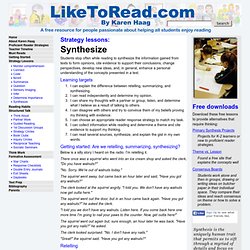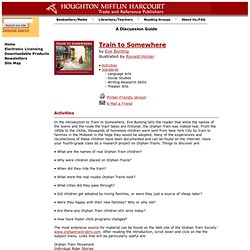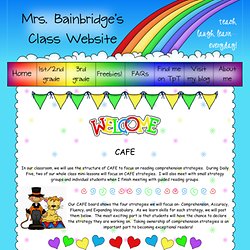

Inferring With Commercials. My favorite reading strategy to teach is inferring.

Local Video Player. Reading Worksheets, Grammar, Comprehension, Lesson Plans. Synthesize. Strategy lessons: Synthesize Students stop often while reading to synthesize the information gained from texts to form opinions, cite evidence to support their conclusions, change perspectives, develop new ideas, and, in general, enhance a personal understanding of the concepts presented in a text.

ELA Units of Study - Wayland Public Schools. Teach Mentor Texts. Inferencing Mini Lessons. These lessons were modified and modeled from ideas in Strategies that Work by Harvey and Goudvis and Reading With Meaning by Miller.

I am currently working on my Masters. One of my projects for a class was to create this HUGE unit using the Understanding By Design Backward Planning Model. I decided to create a unit about inferencing because this is an area I struggled with last year and was not really pleased with how I pulled it all together. Comprehension Strategies - Making connections, questioning, inferring, determining importance, and more. Bloom Taxonomy Book Review Questions. Bloom's Taxonomy Book Review Questions KNOWLEDGE: 1 point each 1.

Make a list of facts you learned from the story. Discussion Guide for Train to Somewhere published by Houghton Mifflin Company. In the introduction to Train to Somewhere, Eve Bunting tells the reader that while the names of the towns and the route the train takes are fictional, the Orphan Train was indeed real.

From the 1850s to the 1920s, thousands of homeless children were sent from New York City by train to families in the Midwest in the hope they would be adopted. Many of the experiences and recollections of these children have been documented and can be found on the Internet. Have your fourth-grade class do a research project on Orphan Trains. Things to discover are: • What are the names of real Orphan Train children? A Train to Somewhere Lesson Plan.
Creating books. The Reader's Notebook. Literature Circle Models. After experimenting for many years, I discovered an approach that's easy, fun, and effective.

I refer to it as Classroom Book Clubs because it's a more relaxed method of doing Literature Circles that doesn't involve roles. You can view a narrated slidecast to this model by scrolling down to the Classroom Book Clubs section. On this page you can also learn about different types of Literature Circles. I've had some success with all the models below, but all models haven't been successful with all groups of students. Read through the various descriptions and find something that feels right to you. Ways to Structure Literature Circles Classroom Book Clubs - My favorite method at the moment is a flexible approach to Literature Circles that does not require the use of extensive handouts and assignment booklets. Classroom Book Clubs I love this model because it's a very flexible and fun approach. Mini Literature Circles (Using Leveled Readers)
Literature Circles Structure: Grades 2-3. In my classroom, literature circles are called "Book Clubs.

" The components of book clubs include choosing a book, reading the book, discussing the book, writing in your journal, and sharing the book by doing an extension project. This is how I begin the year: 1. Setting the Climate: I choose a story from our anthology because I want everyone to read the same story to build a community of readers, and I also want to begin with an author/genre study. How to conduct a Literature Circle.
CAFE. In our classroom, we will use the structure of CAFE to focus on reading comprehension strategies.

During Daily Five, two of our whole class mini-lessons will focus on CAFE strategies. I will also meet with small strategy groups and individual students when I finish meeting with guided reading groups. Our CAFE board shows the four strategies we will focus on- Comprehension, Accuracy, Fluency, and Expanding Vocabulary. As we learn skills for each strategy, we will post them below. The most exciting part is that students will have the chance to declare the strategy they are working on. CAFE. Ricba blog. Adrienne Gear Reading Power Recommended Book Lists. Adrienne Gear's recommended book lists: Fiction Reading Power - Tried & True Connect (Primary, Intermediate), Question (Primary K-3, Intermediate Gr. 4-7), Visualize (Primary, Intermediate), Infer (Primary, Intermediate Gr. 4-7), Transform (Primary, Intermediate Gr. 4-7)

Reading Comprehension & Language Arts Teaching Strategies for Kids. Friday Freebie - Shared Reading in the Upper Elementary. Even big kids need shared reading!

It's the perfect way to model/practice comprehension strategies and build oral fluency, and it only takes 10-15 minutes a day. I'm linking my Shared Reading in the Upper Grades FREEBIE on Freebie Friday at Teaching Blog Addict and Manic Monday on Classroom Freebies. This resource outlines how we share reading each day in room 206 and it includes our shared reading note-taking graphic organizers.
So how do we share reading in room 206? Reader's Workshop. This website is designed and maintained by Karen A. McDavid © 2004. Ideas, content, activities, and documents for this website are copyrighted by Karen A. McDavid and should not be copied or downloaded without permission. All graphics seen throughout this website should not be removed, copied, or downloaded. You may download the banner below with a link back to this site.
Graphics by. 3rd Grade. 3rd Grade Here is where youll find the resources for third-grade classrooms. . . . (to read the remainder of this article, please log in below.) If you are a current member, log in using the form below.